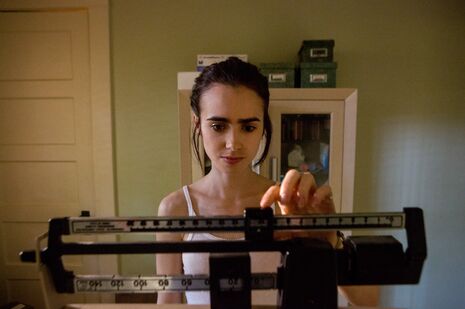Eating disorders are more complex than To The Bone shows
For Ellie Williams, Netflix’s To The Bone does not represent the complexity of eating disorders, or the diversity of those who experience them

When one thinks of someone with an eating disorder, an image very similar to that of Ellen – the main character of Netflix’s To the Bone – is often conjured. The image is of an emaciated yet ethereally beautiful, white teenage girl, and it is an image that has been romanticised and tokenised by online communities for years.
There are more recognisable features which stand out in Ellen; she smokes, she is middle class, and the eating disorder she possesses is ‘anorexia’ – one often characterised in the media by bruised spines, protruding collar bones and sculpted cheek bones. Then there is the treatment she is given. A four-time subject of in-patient residential care, Ellen possesses yet more tokens of a ‘real’ eating disorder. It is a story that those with a past of disordered eating know and fear too well. But eating disorders are not rational – it is also a story that, simultaneously, many people idolise.
At the same time, it is a story that very few people experience. As the film fleetingly shows, there are a number of ways to experience an eating disorder. The character of ‘Kendra’ is notably the only non-white, non-straight, non-thin character with an eating disorder in the film, and is an example of an alternative experience which challenges Ellen’s narrative. It almost feels as if she is a number of ‘examples’ rolled into one, yet the exploration of her character goes little further than to establish these basic personal facts, barely scratching the surface of the hegemonic eating disorder narrative which most other residents somewhat fit into.
“We mustn’t over simplify; To the Bone does not portray eating disorders as a walk in the park by any stretch”
We mustn’t over simplify; To the Bone does not portray eating disorders as a walk in the park by any stretch. We see forced nutrition, uncomfortable coping habits, family trauma and destroyed livelihoods. We see, and I believe the director wants us to see, that eating disorders take over a person’s life – epitomised in Keanu Reeves’ simplified exclamation ‘we aren’t interested in treating people who don’t want to live’, and the countless references to ‘ghosts’ and ‘dead people’. In many parts of To the Bone, we see pain, trauma, bravery and strength – and this is a very commendable aspect of the film.
We also see Ellen, and how she gets very little say in her own recovery, the troubles of others projected onto her taking precedence in an unnerving manner. Finally, we see her hit ‘rock bottom’ and take her first tentative steps towards recovery. The problem is that we see all this through the lens of a film which must attract a wide audience, and thus we see a familiar narrative in a romanticised setting. As body positive Instagram blogger ‘Bodyposipanda’ puts it: “Residential treatment is not a beautiful big house full of people waiting to be your best friend or sweep you off your feet and fall in love with you. It’s also not something that you need to ‘tick off’ so that your eating disorder can be classified as ‘severe’ enough… it’s scary, it’s lonely as fuck, it’s competitive, painful, and alienating, and an experience that a lot of us would rather forget than look back on as a set of fond memories.”.
From many accounts, recovery is slow, uneven and relapses are common. Recovery may not include gaining weight, and overcoming something as all-consuming as an eating disorder is a lot harder than simply shouting ‘Fuck you, voice!’. We see Ellen’s own personal struggle belittled by a much-lauded doctor, who essentially tells her to ‘grow a pair’. This is not how eating disorders work, and Ellen’s struggle isn’t a direct result of her family struggle or her unwillingness to live. It runs far deeper, and she should be given more compassion. Dr Beckham should know that it’s not that simple.
It seems that for many viewers, To the Bone was just that – too close to the portrayal of the impossibly thin, romanticised figure which ‘pro-ana’ blogs idolise, and thus an immensely triggering ordeal. Ellen’s compulsive body monitoring, leading to her achieving the goal of fitting her fingers around her upper arm, is the type of direct goal that many looking for ‘thinspiration’ can cling onto, regardless of how close she may be to dying at the time. Ellen’s graphically depicted ‘rock bottom’ is many people’s goal weight. For others, the movie could not hit home, and failed to take into account the myriad of ways in which disordered eating can manifest itself.
Ultimately, it all comes down to Ellen – the poster girl for the traditional eating disorder narrative. The impossibly thin, ethereal, middle class, and aesthetically ‘messed up’ girl who is tokenised time and time again on tumblr. Achingly tortured yet impossibly beautiful. This isn’t to say that stories such as Ellen’s aren’t worth telling, it is to say that they are worth telling richly, fully, and most importantly truthfully
 News / Cambridge academics stand out in King’s 2026 Honours List2 January 2026
News / Cambridge academics stand out in King’s 2026 Honours List2 January 2026 Comment / Plastic pubs: the problem with Cambridge alehouses 5 January 2026
Comment / Plastic pubs: the problem with Cambridge alehouses 5 January 2026 News / Cambridge businesses concerned infrastructure delays will hurt growth5 January 2026
News / Cambridge businesses concerned infrastructure delays will hurt growth5 January 2026 News / AstraZeneca sues for £32 million over faulty construction at Cambridge Campus31 December 2025
News / AstraZeneca sues for £32 million over faulty construction at Cambridge Campus31 December 2025 Interviews / You don’t need to peak at Cambridge, says Robin Harding31 December 2025
Interviews / You don’t need to peak at Cambridge, says Robin Harding31 December 2025








